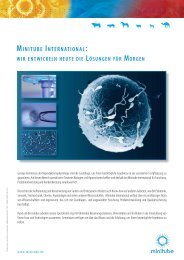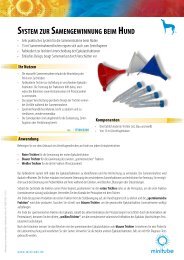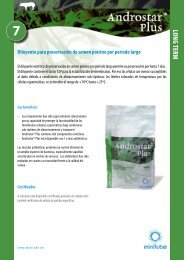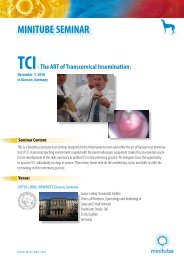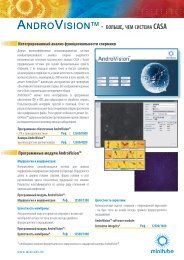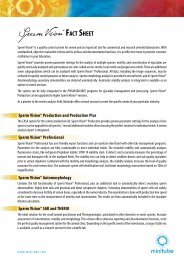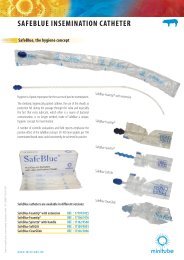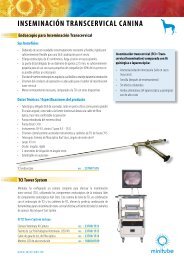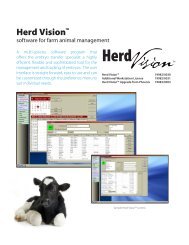TECHNICAL REPORT HYGenius Lab Worktops - MINITÜB GmbH
TECHNICAL REPORT HYGenius Lab Worktops - MINITÜB GmbH
TECHNICAL REPORT HYGenius Lab Worktops - MINITÜB GmbH
You also want an ePaper? Increase the reach of your titles
YUMPU automatically turns print PDFs into web optimized ePapers that Google loves.
<strong>TECHNICAL</strong> <strong>REPORT</strong><br />
04 | 2011<br />
<strong>HYGenius</strong> <strong>Lab</strong> <strong>Worktops</strong><br />
Semen production labs have to fulfill a high hygenic standard<br />
Petra Keiling, Minitüb <strong>GmbH</strong><br />
The work in a semen production laboratory has to meet an increasingly high hygenic<br />
standard. Selecting the right material for worktops is of utmost importance in<br />
an environment where any kind of contamination of the product has to be avoided.<br />
Therefore Minitube has developed a new generation of laboratory worktops out of a<br />
material which has been especially developed according to ISO Standards 1) . The concept<br />
is based on individually customized layouts for the special needs of every lab.<br />
Optimal design for the daily disinfection routine<br />
To ensure optimal conditions for the daily disinfection routine the worktops are designed without 90° angles and edges where bacteria often create<br />
a biofilm allowing their persistence and reproduction. For the same reason, heated plates, displays and equipment bases are integrated in the<br />
surface of the worktops. Cables are hidden in cable channels which is also an important precondition to complete and most efficient disinfection.<br />
Surface Structure<br />
The unique surface structure of the <strong>HYGenius</strong> <strong>Lab</strong> <strong>Worktops</strong> is a non-porous and<br />
sealed white material (Figure 2). In order to stand the high demands of the daily<br />
work in a laboratory the material is very sturdy and durable. The different pieces<br />
of the worktops can be glued together without leaving any gaps or seams (Figure<br />
3). Bacteria and other microorganisms are unable to grow on or to penetrate<br />
the surface (Figure 4). Table 1 shows the minimal water absorption of the material.<br />
Table 1: Water absorbtion<br />
Water absorption in % 24 h 60 d<br />
6 mm 0.04 0.30<br />
12.3 mm 0.03 0.21<br />
19 mm 0.03 0.17<br />
1) e.g. DIN EN ISO 846:1997-10 - Plastics - Evaluation of the action of microorganisms and DIN 53 495 - Waterabsorption<br />
www.minitube.com<br />
Figure 1: Customized concept<br />
Figure 2: Round edges, cable channel, fillet and a non porous material simplify the daily disinfection routine<br />
Figure 3: Seamless combination of worktop units
Figure 4: Number of CFU on <strong>HYGenius</strong> <strong>Lab</strong> surface compared to standard worktops with formica coating (Resopal)<br />
1,5<br />
1,0<br />
0,5<br />
0,0<br />
Contact plate sample 5 minutes after disinfection. Incubation at +37°C . Number of CFU after 48 h.<br />
Chemical resistance of <strong>HYGenius</strong> <strong>Lab</strong> <strong>Worktops</strong><br />
All disinfection agents offered by Minitube (Table 2) can be used.<br />
Table 2: Minitube cleaning and disinfection agents<br />
Cleaning and disinfection agents<br />
Gigasept FF 2 – 8 %<br />
Hexaquart S 1.5 %/60 min, 1 %/4 hours<br />
Meliseptol<br />
The chemical substances listed in Table 3 were tested on <strong>HYGenius</strong> <strong>Worktops</strong> at a contact time of 16 hours. No permanent marks were detected.<br />
Residues could be removed with a damp sponge and bleaching agents. With five of the tested substances, minimal impairments were noted,<br />
which are specified in footnotes (*).<br />
It is not recommended to keep high concentrations of acids or alkalines for longer periods (more than 16 hours) on the surface. The substances<br />
listed in Table 4 are not recommended because they may impair the surface of the worktops.<br />
Table 3: Chemical resistance<br />
Chemicals<br />
Acetone**, CH COCH 3 3<br />
Hydrochloric acid (< 30 %), HCl<br />
Acetic acid 10 %, CH COOH 3 Methanol**, CH OH 3<br />
Sulphuric acid (< 60 %), H2SO4 Perchloric acid, KCIO4 Nitric acid (< 20 %), HNO3 Silver nitrate 10 %, AgNO3 Ethanol**, C H O 2 6 Soap free detergents<br />
Ethyl ether**, C H O 12 12 Sodium hydroxide (< 40 %***), NaOH<br />
Formaldehyde, CH O Rinsing agents<br />
2<br />
** After 16 hours exposure slight lightening of the material possible<br />
*** After 16 hours exposure slight darkening of the material possible<br />
www.minitube.com<br />
Number of Colony Forming Units/cm² after Disinfection<br />
<strong>HYGenius</strong> <strong>Lab</strong> Surface Standard Surface<br />
VRBG + neutralizer for cultivation<br />
and counting of entero bacteria<br />
PCA + TTC + neutralizer for cultivation<br />
and counting of aerobic bacteria
Table 4: Not recommended chemicals<br />
Glacial acetic acid<br />
Acetic acid > 90 %<br />
Phosphoric acid > 75 %<br />
Conclusion<br />
<strong>HYGenius</strong> worktops are specially designed to offer an optimal hygiene environment for semen processing laboratories. The variable shape and<br />
the durable surface provide a high hygienic standard and the precondition for an effective disinfection routine. Each worktop layout is individually<br />
customized for the special needs of the lab.<br />
www.minitube.com



